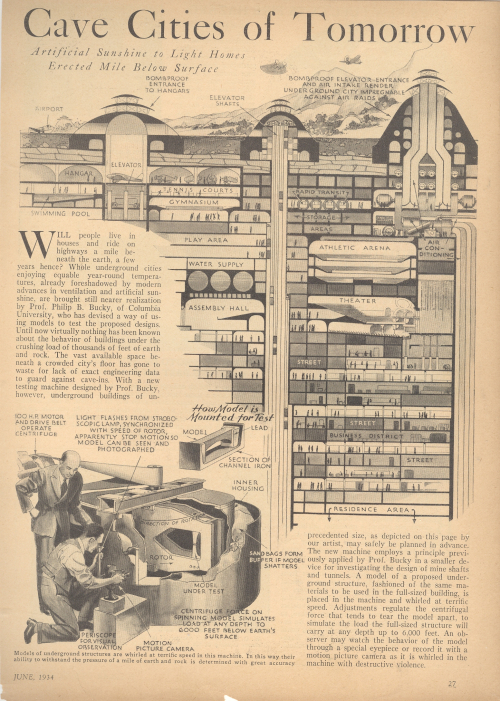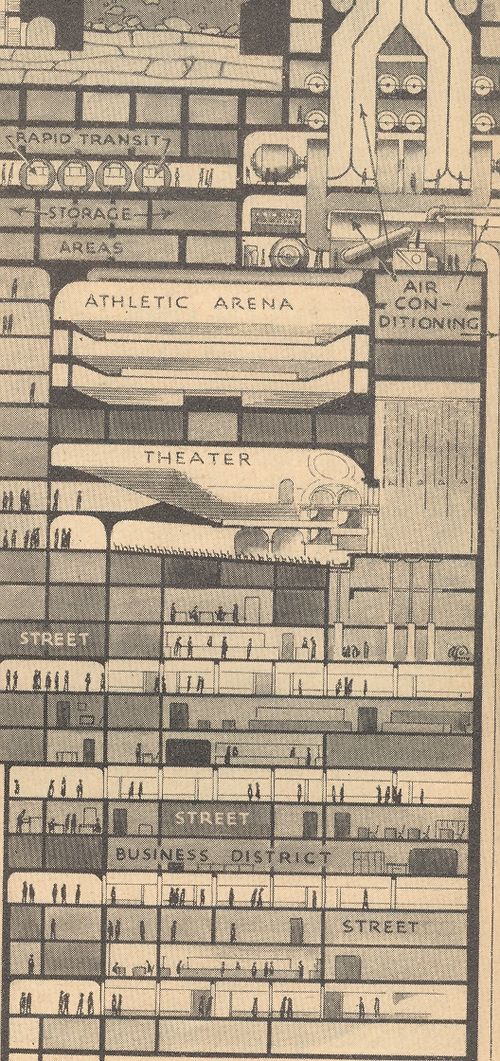JF Ptak Science Books Expanding an earlier post from 2009...
I’m a sucker for cross sections, and this one has it all—nicely drawn, a glimpse into the possibilities of the future, and technoid removed from the realm of possibility. This article appears in Popular Science Monthly for June, 1934, and presents the possibility of extending downward into the earth for future city development. (as a matter of fact, the fabulous Modern Mechanix site has a similar story on display, asking the question “Are Skyscrapers Doomed?” for the same year, with the same engineers.) Well. It seems as though in this cross section that residences for people begin below the thirtieth floor, making living quarters starting at about 350’ down. The story goes that it would be possible to dig these cities up to about 6,000 feet into the earth, which of course is a long way down. Its difficult enough to drill an oil well hole to this depth; its difficult to imagine digging/outfitting/removing the earth from something—I’m not even sure what to call it—that was, potentially, thousands of feet deep and miles wide and long. That’s playing with figures hundreds of billions of cubic feet. Of construction. Underground. Well, I guess it wouldn't be necessarily underground--it could be an excavated hole that is a mile or two wide and across and down, which would make the hole itself several times larger than the largest whole ever dug by humans, which is the Bingham Canyon Mine, a pit slope mine that is about .5miles x 2.5 miles. And then construction would begin after which the remaineder would be covered by earth.
Anyway, it is a big hole and a lot of construction, the volume of it at the beginner phases of say a cubic mile would be equal to the volume of 25,000 Great Pyramids or 5,400 Empire State Buildings. It would be easier probably to build a vertical city in part of the Grand Canyon (or of course a "more modest canyon" and then cover it up--that's an idea you won't see in print too often. (I should poitn out that I've bumped into canyon-filling ideas every now eand then, one of my favorite truly-floated ideas being the one that would fill up Washington D.C.'s Rock Creek Park, which snakes its way north-south in the central part of the city. Around 1890 the Federal government was trying to figure out how to best multi-task the area for parkland and roadway. One incredible plan called for the creek, which in many places is bounded by some pretty steep embankments (25-75 feet or so) and extends about 8 miles north of downtown, to be filled in, leveled off, and paved over. Now that would've been a lot of dirt. The final plan was perfectly fine and had a series of small roads snaking their way through the park, making it one of the nicest rides (Central Park-like) of any major metropolitan cities in North America.)





Comments